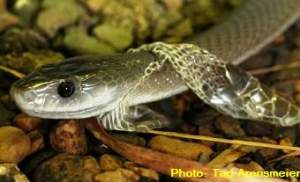Did you know that snake skin/scales are made up of keratin, the same material of our hair and nails?
Epidermis: characterized by complete covering of keratin (the same stuff that makes up mammalian hair and mammalian, avian, and reptilian nails/claws also makes up the plates we call “scales”). The keratin may be thick, as on the belly and tail, or thin, as on the dewlap. The hard spikes on such lizards as bearded dragons and horned lizards are just harder bits of integument, as are the keeled ridges on many snakes’ scales and some lizards, such as some iguanas. The keratin is composed of many layers of very thin, flat cells. The closer they get to the surface of the reptile, the more highly compacted they are as they are pressed against by new keratin cells being formed lower down in the epidermal layer, the stratum germinativum. Three such layers of increasingly compacted keratin cells are formed called, from the surface inward toward the stratum germinativum, the Oberhautchen layer, the beta-keratin layer, and the alpha-keratin. Some reference the epidermis as being three layers:
Stratum corneum: heavily keratinized outer layer.
Intermediate zone: composed of stratum germinativum cells in various stages of development.
Stratum germinativum: the deepest layer, consisting of cuboidal cells. Undergoes mitosis to form the intermediate zone.
During shedding (ecdysis), the mitosis in the stratum germinativum forms the new cells moved up to the intermediate zone and those cells up to the stratum corneum. It is during this time that the skin is metabolically active and it in this period of activity that healing will occur. Otherwise, skin is essentially inert.
Exception to the norm… The exception to the above is the chelonians. Their shell, which many people think is just bone, is actually covered with living tissue composed of keratinized epidermis covering the underlying dermal plate which is itself the chelonians vertebrae and rib cage. (Thus, the practice of piercing a chelonians’s shell to put a ring in with which to tether chelonian (which is in itself inhumane), or to decorate it with stud earrings, is akin to our puncturing our skulls.)
Dermis: consists of connective tissue. In some reptiles, there may be small bones called osteoderms. These are what form the distinctive specialized scales on savannah monitors and crocodilians, for example.
Reptile skin heals much more slowly than mammalian skin, often taking about 6 weeks for the defect to be fully restored.
Sources:
http://www.anapsid.org/basicdermatology.html
